Photoshop is one of the leading vector graphic software available on the market. Photoshop is used by both professionals and hobbyists to do tasks. From time to time, Photoshop may develop problems and issues that need addressing. Some issues may be related directly to Photoshop, and some will be caused by the user’s computer hardware or software.
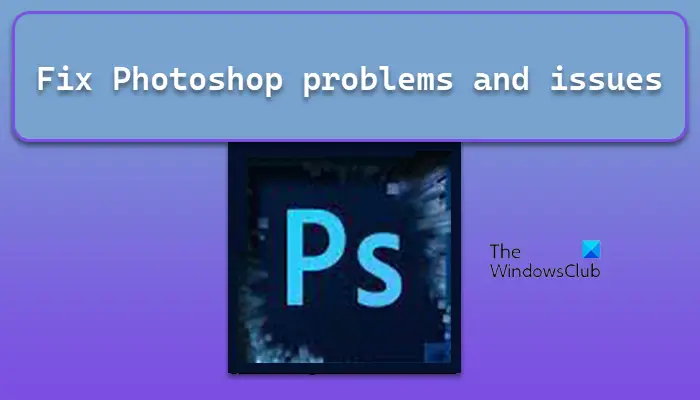
Fix Photoshop problems and issues like quitting, closing itself, etc.
Whenever Photoshop has any issue, try to look at the simplest solutions first and move up to the more complex. As stated previously, issues may be related to Photoshop or the user’s computer software or hardware.
If Photoshop faces problems and issues like quitting, closing itself, etc. on Windows 11/10, here are some working solutions to help you successfully fix the issue, Some issues may be fixed by a simple restart or may require complete hardware or software change.
- Force quit and restart Photoshop or restart your computer
- Check for a Known issue in Photoshop
- Update Photoshop to the latest version
- Reset Photoshop’s Preferences
- Troubleshoot GPU and Graphics Driver
- Keep your Windows Operating System up to date
- Other Troubleshooting Tips
1] Force Quit and Restart Photoshop or Restart Your Computer
Whenever there is an issue, look for the simplest solution. Whenever Photoshop crash, one of the first things to try is to restart Photoshop or your computer or both. Restarting will clear any issues out of memory. Maybe the crash could have been the result of the RAM being full or something causing processes to become corrupt. Restarting could help clear up those issues.
2] Check for a Known issue in Photoshop
The Adobe website is the best place to go to check for known issues and solutions. They are dedicated to taking users’ complaints and addressing them. They will put known issues and their solutions on their website, so it is good to check their website to see if the problem that you are having is listed there and the solution. You may also check the Adobe Community where persons will state their issues and these issues will be addressed by Adobe professionals and other persons who may have found ways to fix the issues.
Related: Photoshop keeps crashing or freezing on Windows PC
3] Update Photoshop to the Latest Version
While updates are to add new features, they also serve the issue of fixing bugs and addressing vulnerabilities and compatibility issues. Keeping Photoshop updated with the latest version is one way to avoid crashes.
4] Reset Photoshop’s Preferences
Unexpected behaviors in Photoshop may be an indication that the preferences may be damaged. Restoring preferences to their default is a great way to troubleshoot to see if the preferences are causing the unexpected behavior.
Be sure to backup your preferences before resetting preferences.
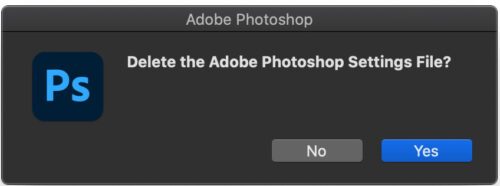
To reset Photoshop’s preferences using the keyboard quit Photoshop, hold down the Ctrl + Alt + Shift key and launch Photoshop. Click Yes in the dialog that asks, “Delete the Adobe Photoshop Settings file?”
You may reset Photoshop’s preference using the Preferences dialogue window. Go to Edit then Preferences then General or press Ctrl + K and choose General. You then press Reset Preferences on Quit. Click OK in the dialog that asks, “Are you sure you want to reset preferences when quitting Photoshop?” Close Photoshop then reopen Photoshop. New Preference files will be created in the original location.
Note – This method is for newer versions of Photoshop, the older version does not offer the reset button on the Preference dialogue window.
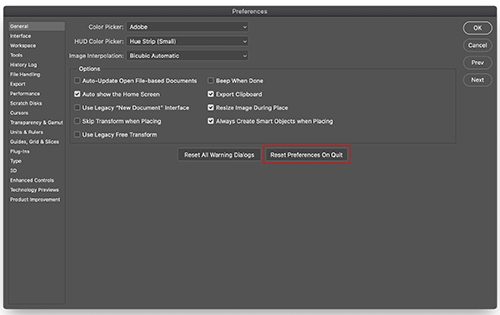
You may manually reset preferences by removing the preferences folder. This method ensures all preferences and any user presets which may be causing a problem are not loaded. To try this method close Photoshop and then navigate to the location of the preferences folder. They are located at Users/[user name]/AppData/Roaming/Adobe/Adobe Photoshop [version]/Adobe Photoshop [version] Settings. If you do not see the files, they may be hidden so you may have to view hidden files.
Remove the entire Adobe Photoshop [Version] Settings folder to somewhere safe for a backup of your settings. Open Photoshop and new preferences files will be created in the original location.
5] Troubleshoot GPU and Graphics Driver
Resolve issues caused by defective, unsupported, or incompatible GPU or graphics driver.
With newer versions of Photoshop, you can run the graphics processor compatibility check to ensure your GPU is compatible:
Go to Help > GPU Compatibility and see the report dialog that opens.
Quickly determine if the issue is related to your graphics processor or driver by disabling the GPU acceleration.
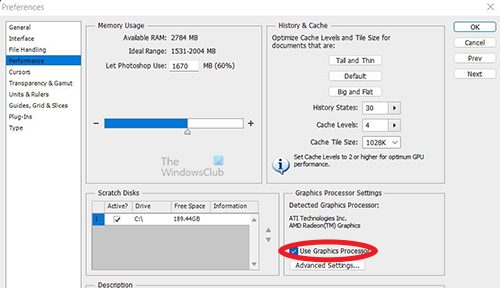
Go to Photoshop’s Preferences > Performance and uncheck Use Graphics Processor and restart Photoshop.
If the problem goes away, continue troubleshooting by performing the GPU and graphics driver troubleshooting steps.
GPU ad Graphics Driver Troubleshoot Steps:
– Confirm that you are using the latest version of Photoshop
- Confirm that your graphics card is compatible with Photoshop.
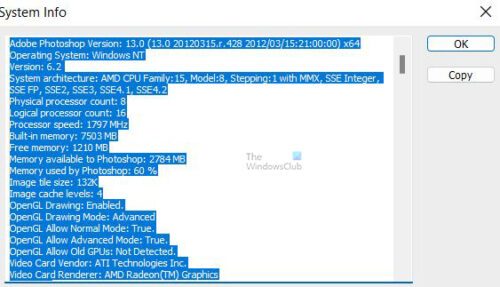
To determine your graphics card, make and model, launch Photoshop, and choose Help > System Info to see the Graphics Processor info:
Note:
If you are experiencing flickering or stuttering responsiveness within Photoshop, and you have a GPU that supports G-Sync, turn G-Sync off for Photoshop using the NVIDIA control panel.
– Updating your graphics driver can fix many issues, such as crashing, incorrectly rendered images, and performance problems.
Get driver updates directly from the video card manufacturer, Windows Update won’t always give you the latest and greatest drivers. You must go directly to your card manufacturer’s website to check for driver updates
After installing the updates, relaunch Photoshop. Turn on Use Graphics Processor by choosing Preferences > Performance > Use Graphics Processor and retry the steps that caused the problem.
– Check your Cache Levels setting.
If you’ve set your Cache Levels to 1 in Photoshop preferences, you may experience performance issues with features that take advantage of the graphics processor.
Reset the Cache Levels to the default setting, which is 4:
- Choose Edit > Preferences > Performance (Windows) or Photoshop > Preferences > Performance (macOS).
- Set Cache Levelsto 4.
- Quit and relaunch Photoshop.
After relaunching Photoshop, retry the steps that caused the problem.
– Reset the Preferences
Resetting preferences return Graphics Processor settings to their default status.
– Change your Advanced Settings for Open CL.
Choose Edit > Preferences > Performance, In the Performance panel, click Advanced Settings, Uncheck Open CL, set Drawing Mode to Basic quit, and relaunch Photoshop.
If you’re changing Performance preferences to troubleshoot a problem, relaunch Photoshop after each change.
– Configuring computers with multiple graphics cards.
Ultralight laptops and low-end desktops, often use an integrated graphics card that uses less power to preserve battery and shares memory with your CPU.
Higher end computers often have a discrete, dedicated graphics card that uses its own memory (VRAM), has greater processing power, and doesn’t eat up RAM.
Higher-end laptops often use two graphics cards, an integrated one when you’re using the battery, and a discrete graphics card when you’re plugged into an outlet.
If your system has more than one graphics card, ensure that Photoshop has been assigned the High-Performance graphics card rather than the Integrated Graphics or Power-Saving graphics card for the best experience. Changing these settings on laptops will increase battery usage.
NVIDIA:
- Right-click anywhere on the desktop and choose the NVIDIA control panel.
- Click Manage 3D settings.
- Click Program Settings and add exe and sniffer.exe. Change the preferred graphics processor to High-performance NVIDIA processor.
AMD:
- Right-click anywhere on the desktop and choose the AMD Catalyst Control Center or Configure Switchable Graphics.
- Click Browse and choose High Performanceinstead of Power Saving.
– Disable less powerful graphics card
If the above step does not resolve issues when using more than one graphics card, consider disabling one of the graphics cards. Before disabling the onboard graphics card, please ensure you have the video output of your monitor connected to the dedicated graphics card.
Note:
- Disabling the graphics card may lead to system instabilities, so be careful.
- Read your card’s instructions carefully and contact the video adapter manufacturer directly if you don’t understand the instructions.
– Do not use Photoshop on a virtual machine (VM).
According to Adobe, running Photoshop under virtual machines (VMs) is not tested extensively nor officially supported because of known issues with features that rely on the graphics processor in VM environments.
– Purchase a compatible graphics card or disable the graphics processor.
If none of the troubleshooting steps above solve the issue, your last option is to purchase a compatible graphics card, or completely disable the graphics processor. To disable the graphics processor launch Photoshop, choose Edit then Preferences, Performance, deselect Use Graphics Processor, quit, and relaunch Photoshop.
Common issues caused by a defective, unsupported, graphics driver or incompatible graphics processor (also called a graphics card, video card, or GPU):
- Crashes, performance issues, incorrectly-rendered windows or objects, canvas flashes/flickers, artifacts in Photoshop.
- Photoshop crashes or hangs upon launch.
- Image canvas flashes or flickers.
- Photoshop’s menu bar is missing.
Note – When purchasing a computer, think of all the possible uses that you have for it and then choose one that is compatible. Research the computer and the software, check compatibility and system requirements for the computer and software to work. This will save you the expense of having to buy a new computer or parts later.
6] Keep your Windows Operating System up to date
There are a lot of advantages to keeping your Windows operating system up to date. These advantages range from better protection from intrusion to better performance for hardware and software, Photoshop will perform better with an operating system that is up to date, the makers of Photoshop, Adobe, keep up with the latest updates and check for compatibility issues then make sure that their software are compatible. This means that if your software is outdated, you may have compatibility and performance issues.
To check for updates and to verify that you are up to date, click Start then choose the Settings Icon (Gear Icon), in the left panel choose, Windows Update. You will see if you are up to date. You may click Check for Updates.
You can also go down to Advanced Options and check if there are optional updates. Optional updates may include updates from your manufacturer or Windows Updates that they thin are not priority.
7] Other Troubleshooting Tips
– Inadequate cooling
There are other things that may be causing Photoshop to crash. Your computer may not be getting proper ventilation, so it is overheating. When computers overheat, they tend to slow down until they cool down. Photoshop is a high-demand software, and it will cause the computer to heat up quickly. If the ventilation system is not performing well, the computer will slow down performance will be lowered, this can cause issues with Photoshop. You may have to clean the vents and fans and purchase cooling pads for laptops and get high-performance fans for desktops. If the ambient temperature is very hot, especially in summer, you may have to turn on a fan or other cooling device. Check the status of the thermal paste between the CPU fan and the CPU, performance can be greatly improved if the thermal paste is replaced.
Note – Get professional help if you do not know how to do technical work on your computer.
– Power Cord Unplugged
Check to see if Photoshop crashes or performs slower when the power cable is unplugged from your laptop. Some manufacturers will set the laptop to perform less than the optimal performance if the power cord is unplugged. Laptops with two GPUs will use the low-performing one when the power cord is unplugged, this is done to conserve battery power. Before you buy research the specific brand and series computer, read and listen to reviews from other persons who have purchased it and who may be using it for the same purpose as you. The issue of lowered performance may not be an issue for some applications, however for Photoshop that could cause crashes or freezes.
– Identify a Problematic Plug-in
To quickly determine whether Photoshop is crashing due to a problematic optional or third-party plug-in, do the following:
- Close Photoshop.
- Hold down the Shift key and launch Photoshop. A dialog appears during the launch that reads Skip loading optional and third-party plug-ins.
- Click Yes to skip loading optional and third-party plug-ins.
- Launch Photoshop.
If Photoshop launches successfully, an installed optional or third-party plug-in is causing the problem.
Fix this issue be removing the plug-ins then putting them on one by one. After you put on each one, restart photoshop and see if it functions. Whatever one causes the problem can them be removed.
– Reset the Photoshop Font Cache
A bad font or fonts can cause general performance issues, including crashes or hang when launching or using Photoshop. The Photoshop font cache contains the enumerated list of fonts and font features installed on the system that Photoshop can use. Deleting this font cache file will allow Photoshop to create a new one.
- Exit Photoshop and the Creative Cloud desktop app
- Navigate to \Users\[user name]\AppData\Roaming\Adobe\Adobe Photoshop <version>
- Delete the CT Font Cache folder and empty the Recycle Bin
Additionally, if you have too many fonts installed it can affect the overall performance of your computer. It is nice to have lots of nice fonts available, however, downloading too much can cause your computer to move slower or hang up.
Read: Photoshop crashes when printing on Windows 11/10
What do I do If these Fixes do not Help?
There is always the possibility that there may be a bug in a newer update of Photoshop. Reverting to a previous version may help with the problem. There are times when a newer version has bugs and Adobe will eventually release a version update that will fix the bugs. This means it is important to check the Adobe website for possible updates and fixes.
Read: Photoshop Tips and Tricks for Beginners
Which is better for Graphics Design, Laptop or Desktop Computer?
Desktop computers are usually better for demanding processes as they can be upgraded much easier for performance and cooling. However, laptops are needed for cases where a desktop may not be a practical solution, for example, mobile office, unstable power, etc. Desktop computers usually have components that are generally more powerful.
However, laptops designed for gaming or graphics designing can be just as powerful. The issue is that when compared, the equally powerful laptop is usually far more expensive. Another factor to consider is that desktops are easier to upgrade because some components may still be able to be used if others are upgraded. Laptops on the other hand do not give many upgrade options, so you may need to purchase a new one.
How do I find the Thermal Paste, and How do I Know if I Need to Change It?
The thermal paste is usually sandwiched between the CPU and the cooling fan or heatsink on the CPU. The thermal paste is there to help with the cooling of the CPU. If the thermal paste looks dry and flaky, then it needs changing; get professional help to disassemble your computer and apply the thermal paste.
Read next: Illustrator keeps crashing, freezing, closing, lagging, or is not responding.
Leave a Reply